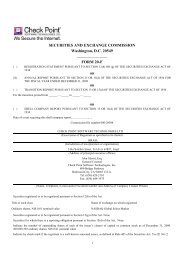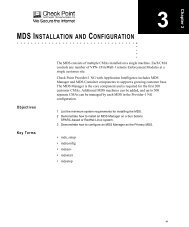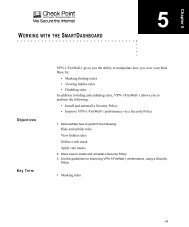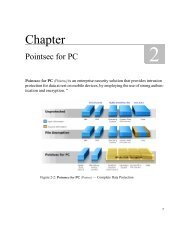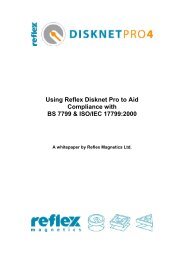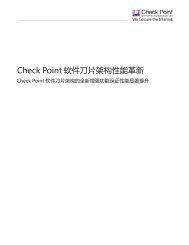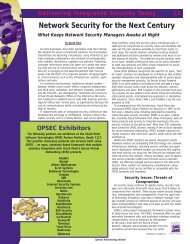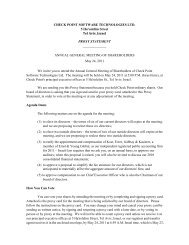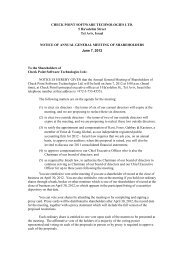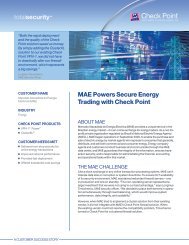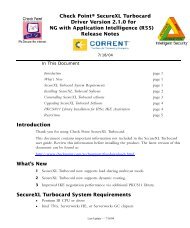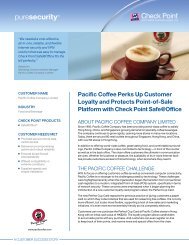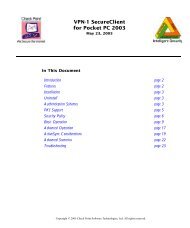printmgr file
printmgr file
printmgr file
Create successful ePaper yourself
Turn your PDF publications into a flip-book with our unique Google optimized e-Paper software.
CHECK POINT SOFTWARE<br />
FORM 20-F DFN ON-BOA<br />
ˆ200FDMqk04d==nK76Š<br />
200FDMqk04d==nK7<br />
RR Donnelley ProFile wcrdoc1<br />
10.10 WCRjacis0in 26-Mar-2012 14:39 EST<br />
229899 FIN 16 1*<br />
PAL<br />
09-Apr-2012 13:21 EST CURR<br />
PS IFV 1C<br />
CHECK POINT SOFTWARE TECHNOLOGIES LTD.<br />
AND ITS SUBSIDIARIES<br />
NOTES TO CONSOLIDATED FINANCIAL STATEMENTS<br />
NOTE 2:- SIGNIFICANT ACCOUNTING POLICIES (Cont.)<br />
future undiscounted cash flows the asset (or asset group) is expected to generate. If the asset is<br />
considered to be impaired, the amount of any impairment is measured as the difference between the<br />
carrying value and the fair value of the impaired asset. During 2009, 2010 and 2011, no impairment<br />
loss was recorded.<br />
In determining the fair values of long-lived assets for purpose of measuring impairment, the<br />
Company’s assumptions include those that market participants will consider in valuations of similar<br />
assets.<br />
i. Business combinations:<br />
The Company accounts for business combinations in accordance with ASC No. 805, “Business<br />
Combinations”. ASC 805 requires recognition of assets acquired, liabilities assumed, and any<br />
non-controlling interest at the acquisition date, measured at their fair values as of that date. The ASC<br />
also requires the fair value of acquired in-process research and development (“IPR&D”) to be recorded<br />
as an indefinite life intangible asset (subject to impairment) until the research and developments efforts<br />
are either completed or abandoned, and restructuring and acquisition-related costs to be expensed as<br />
incurred. Any excess of the fair value of net assets acquired over the purchase price and any subsequent<br />
changes in estimated contingencies are to be recorded in earnings. In addition, changes in valuation<br />
allowance related to acquired deferred tax assets and acquired income tax positions are to be<br />
recognized in earnings.<br />
j. Research and development costs:<br />
Research and development costs are charged to the statement of income as incurred. ASC 985-20,<br />
“Software- Costs of Software to Be Sold, Leased, or Marketed”, requires capitalization of certain<br />
software development costs subsequent to the establishment of technological feasibility.<br />
Based on the Company’s product development process, technological feasibility is established upon<br />
completion of a working model. Costs incurred by the Company between completion of the working<br />
models and the point at which the products are ready for general release, have been insignificant.<br />
Therefore, all research and development costs are expensed as incurred.<br />
k. Revenue recognition:<br />
The Company derives its revenues mainly from products, licenses, combined hardware and software<br />
products, software updates and maintenance and subscriptions. The Company’s products are generally<br />
integrated with software that is essential to the functionality of the equipment. The Company sells its<br />
products primarily through channel partners including distributors, resellers, OEMs, system integrators<br />
and MSPs, all of whom are considered end-users. The Company also sells its products directly to end<br />
users primarily through its web site.<br />
Starting January 1, 2011 the Company adopted the guidance of ASU 2009-14, Certain Arrangements<br />
That Include Software Elements, (amendments to FASB ASC Topic 985, Software) (“ASU 2009-14”)<br />
and ASU 2009-13, Multiple-Deliverable Revenue Arrangements, (amendments to FASB ASC Topic<br />
605, Revenue Recognition) (“ASU 2009-13”). ASU 2009-14 removes tangible products from the scope<br />
of software revenue guidance and provides guidance on determining whether software deliverables in<br />
an arrangement that includes a tangible product are covered by the scope of the software revenue<br />
guidance. ASU 2009-13 requires entities to allocate revenue in an arrangement using estimated selling<br />
prices of the delivered goods and services based on a selling price hierarchy. The amendment<br />
F-16



